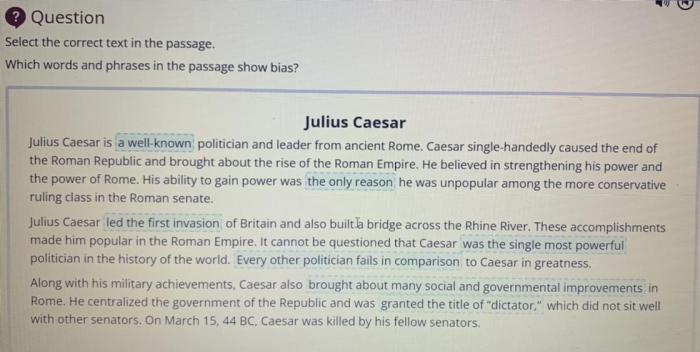The Cask of Amontillado Study Questions delves into the intricate details of Edgar Allan Poe’s classic tale, providing a comprehensive framework for analyzing its characters, setting, symbolism, themes, and literary devices.
This guide offers a thorough examination of the story’s elements, fostering a deeper understanding and appreciation of Poe’s masterful storytelling.
Character Analysis
The “Cask of Amontillado” features two main characters, Montresor and Fortunato, whose complex personalities and interactions drive the story’s plot and themes.
Montresor
Montresor, the narrator and protagonist, is a vengeful and calculating individual. He has been wronged by Fortunato and harbors a deep desire for revenge. Montresor is meticulous in his planning and execution of his revenge plot, demonstrating his cunning and ruthlessness.
Fortunato
Fortunato, the antagonist, is a wealthy and arrogant man who is easily manipulated by Montresor’s flattery. He is prideful and boastful, believing himself to be a connoisseur of fine wines. Fortunato’s lack of caution and gullibility contribute to his downfall.
Interactions between Montresor and Fortunato
The interactions between Montresor and Fortunato reveal their contrasting personalities. Montresor’s cold and calculated demeanor contrasts with Fortunato’s jovial and trusting nature. As the story progresses, Montresor’s manipulation and Fortunato’s vulnerability become increasingly evident, highlighting the power dynamics between the two characters.
Setting and Atmosphere
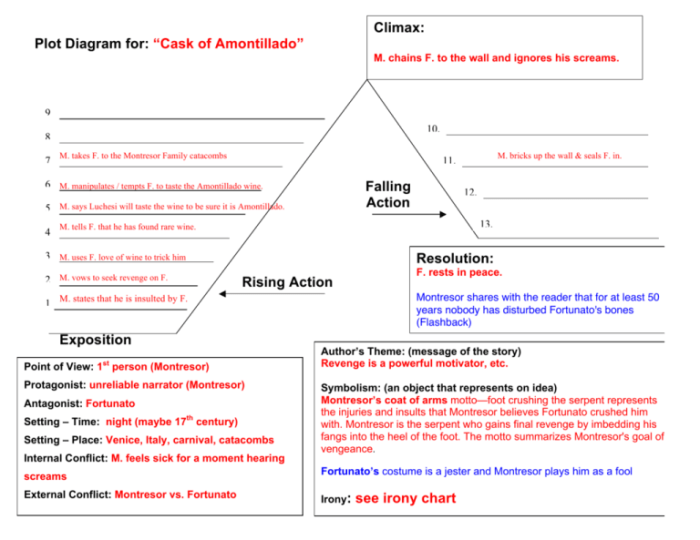
The setting of “The Cask of Amontillado” is a dark and claustrophobic catacomb, which contributes significantly to the story’s atmosphere of suspense and horror.
Description of the Catacombs
The catacombs are described as a “maze of darkness” with “vaulted passages” and “labyrinthine windings.” The damp and musty air, combined with the flickering light of Montresor’s torch, creates a sense of disorientation and unease.
Use of Light and Darkness
The story’s use of light and darkness is symbolic. The flickering torchlight represents Montresor’s cunning and the darkness symbolizes the impending doom that awaits Fortunato. The contrast between light and darkness creates a sense of foreboding and uncertainty.
Use of Sound and Silence
Sound and silence also play a significant role in building tension. The silence of the catacombs is broken by the sound of Montresor’s footsteps and Fortunato’s coughing. These sounds create a sense of isolation and vulnerability, adding to the story’s atmosphere of suspense.
Symbolism and Imagery
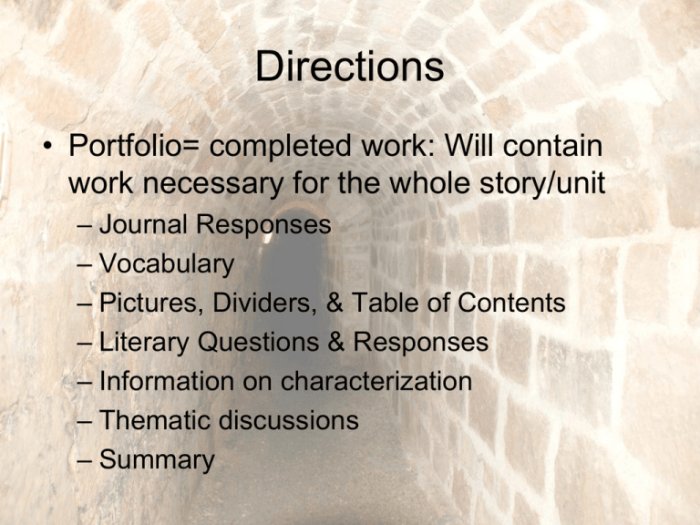
Edgar Allan Poe’s “The Cask of Amontillado” is rich in symbolism and imagery that enhance the story’s themes and atmosphere.
Symbols
- The Cask of Amontillado: The cask of wine represents Fortunato’s pride and his ultimate downfall.
- The Catacombs: The catacombs symbolize death and decay, foreshadowing Fortunato’s demise.
- The Jester’s Cap and Bells: These objects symbolize Fortunato’s foolish and carefree nature.
Irony and Foreshadowing
The story employs irony and foreshadowing to create a sense of suspense and inevitability.
- Irony: Montresor’s claim to be “a man to be trusted” is ironic considering his true intentions.
- Foreshadowing: The story contains subtle hints of Fortunato’s impending doom, such as the mention of the “catacombs of the Montresors” and Fortunato’s cough.
Color and Light
The story’s use of color and light contributes to its symbolic and atmospheric elements.
- Red: The color red, associated with blood and danger, appears throughout the story, foreshadowing Fortunato’s violent end.
- Light and Darkness: The contrast between light and darkness creates a sense of foreboding and uncertainty, reflecting the characters’ shifting power dynamics.
Themes and Meanings
Edgar Allan Poe’s “The Cask of Amontillado” explores several significant themes that resonate with human nature and the human condition.
Revenge
The story’s central theme is revenge. Montresor’s meticulous planning and execution of his revenge plot against Fortunato highlights the destructive nature of unchecked anger and the desire for retribution.
Pride and Hubris
Fortunato’s excessive pride and hubris contribute to his downfall. His arrogance and belief in his own superiority make him an easy target for Montresor’s manipulation.
Betrayal
Montresor’s betrayal of Fortunato is a key element of the story. His act of luring Fortunato into the catacombs and entombing him alive highlights the dangers of misplaced trust and the consequences of betrayal.
Literary Devices
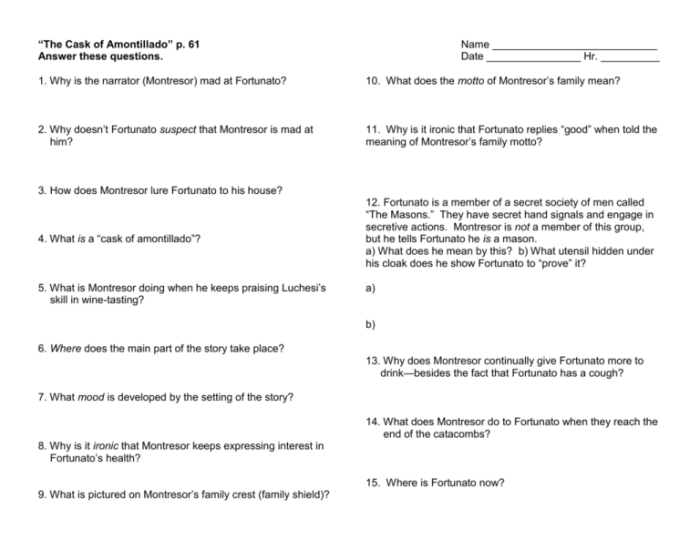
Edgar Allan Poe employs various literary devices in “The Cask of Amontillado” to enhance the story’s impact and create a sense of suspense and tension.
Foreshadowing
The story contains subtle hints of Fortunato’s impending doom, such as the mention of the “catacombs of the Montresors” and Fortunato’s cough. These foreshadowing elements create a sense of unease and anticipation.
Symbolism
Poe uses symbolism throughout the story to enhance its themes and atmosphere. The cask of Amontillado, the catacombs, and the jester’s cap and bells all carry symbolic meanings that contribute to the story’s overall impact.
Irony
Irony is also present in the story. For example, Montresor’s claim to be “a man to be trusted” is ironic considering his true intentions. This use of irony adds depth to the characters and creates a sense of suspense.
Historical and Cultural Context
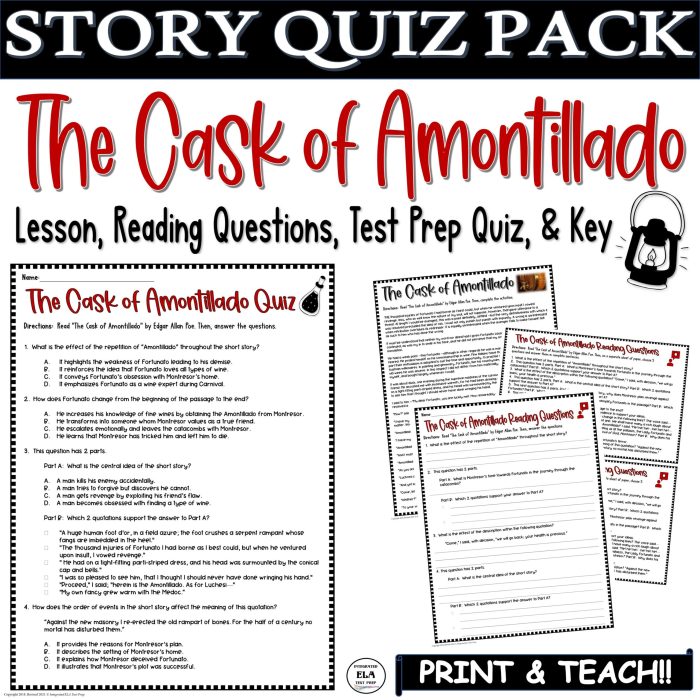
Edgar Allan Poe’s “The Cask of Amontillado” was written in the mid-19th century, a time of significant social and cultural change.
Historical Context
The story reflects the fascination with death and decay that was prevalent in the Victorian era. The setting of the catacombs and the emphasis on the macabre reflect the era’s preoccupation with mortality and the afterlife.
Cultural Context, The cask of amontillado study questions
The story also reflects the cultural values of the time. Montresor’s desire for revenge and his willingness to resort to violence were influenced by the prevailing code of honor and the belief in retribution.
Influence on Later Works
“The Cask of Amontillado” has had a profound influence on later works of literature and popular culture. Its themes of revenge, pride, and betrayal have been explored in countless stories, films, and other artistic creations.
FAQ Resource: The Cask Of Amontillado Study Questions
What is the significance of the setting in The Cask of Amontillado?
The dark and claustrophobic catacombs create a sense of foreboding and isolation, reflecting the characters’ inner turmoil and the impending tragedy.
How does the use of foreshadowing contribute to the story’s suspense?
Poe employs subtle hints and anticipatory language to build tension and create a sense of inevitability, gradually revealing the narrator’s sinister intentions.
What is the symbolic meaning of the cask of Amontillado?
The cask represents both the narrator’s desire for revenge and the ultimate fate of his victim, symbolizing the destructive power of unchecked emotions.
